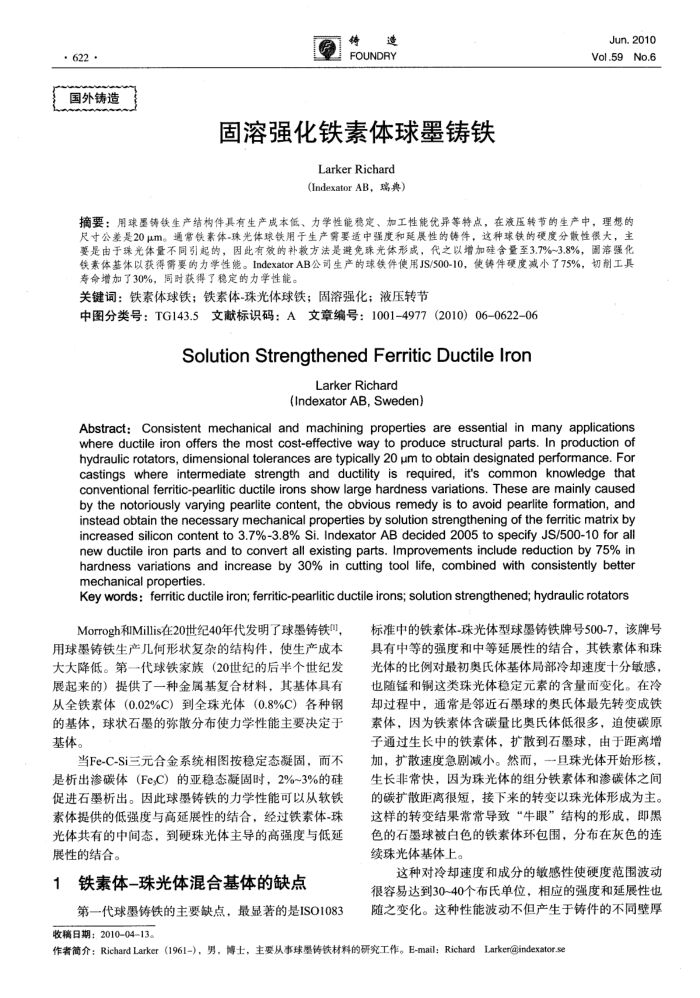您当前的位置:首页>论文资料>固溶强化铁素体球墨铸铁
内容简介
 · 622 ·
· 622 ·国外铸造
铸造 FOUNDRY
固溶强化铁素体球墨铸铁
Larker Richard(Indexator AB,瑞典)
Jun.2010 Vol.59No.6
摘要:用球墨铸铁生产结构件其有生产成本低、力学性能稳定、加工性能优异等特点,在液压转节的生产中,理想的尺寸公差是20um。通常铁素体-珠光体球铁用于生产雾要适中强度和延展性的铸件,这种球铁的硬度分散性很大,主要是由于殊光体量不同引起的,因此有效的补救方法是避免殊光体形成,代之以增加硅含量至3.7%~3.8%,围溶强化铁素体基体以获得雷要的力学性能。IndexatorAB公司生产的球铁件使用JS/500-10,使铸件硬度减小了75%,切削工具寿命增加了30%,同时获得了稳定的力学性能。
关键词:铁素体球铁;铁素体-珠光体球铁;固溶强化:液压转节
中图分类号:TG143.5文献标识码:A文章编号:1001-4977(2010)06-0622-06
SolutionStrengthened FerriticDuctile Iron
Larker Richard
(IndexatorAB,Sweden)
Abstract:Consistent mechanical and machining properties are essential in many applications where ductile iron offers the most cost-effective way to produce structural parts. In production of hydraulic rotators, dimensional tolerances are typically 2o μm to obtain designated performance. For castings where intermediate strength and ductility is required, it's common knowledge that conventional ferritic-pearlitic ductile irons show large hardness variations. These are mainly caused by the notoriously varying pearlite content, the obvious remedy is to avoid pearlite formation, and instead obtain the necessary mechanical properties by solution strengthening of the ferritic matrix by increased silicon content to 3.7%-3.8% Si. Indexator AB decided 2005 to specify JS/500-10 for all new ductile iron parts and to convert all existing parts. Improvements include reduction by 75% in hardness variations and increase by 3o% in cutting tool life, combined with consistently better mechanicalproperties.
Key words: ferritic ductile iron; ferritic-pearlitic ductile irons; solution strengthened; hydraulic rotators
Morrogh和Millis在20世纪40年代发明了球墨铸铁,用球累铸铁生产几何形状复杂的结构件,使生产成本大大降低。第一代球铁家族(20世纪的后半个世纪发展起来的)提供了一种金属基复合材料,其基体具有从全铁素体(0.02%C)到全珠光体(0.8%C)各种钢的基体,球状石墨的弥散分布使力学性能主要决定于基体。
当Fe-C-Si三元合金系统相图按稳定态凝固,而不是析出渗碳体(FeC)的亚稳态凝固时,2%~3%的硅促进石墨析出。因此球墨铸铁的力学性能可以从软铁素体提供的低强度与高延展性的结合,经过铁素体-珠光体共有的中间态,到硬珠光体主导的高强度与低延展性的结合。
铁素体-珠光体混合基体的缺点 1
第一代球墨铸铁的主要缺点,最显著的是ISO1083 收稿日期:201004-13。
标准中的铁素体-珠光体型球墨铸铁牌号500-7,该牌号具有中等的强度和中等延展性的结合,其铁素体和珠光体的比例对最初奥氏体基体局部冷却速度十分敏感,也随锰和铜这类珠光体稳定元素的含量而变化。在冷却过程中,通常是邻近石墨球的奥氏体最先转变成铁素体,因为铁素体含碳量比奥氏体低很多,迫使碳原子通过生长中的铁素体,扩散到石墨球,由于距离增加,扩散速度急剧减小。然而,一且珠光体开始形核,生长非常快,因为珠光体的组分铁素体和渗碳体之间的碳扩散距离很短,接下来的转变以珠光体形成为主。这样的转变结果常常导致“牛眼”结构的形成,即黑色的石墨球被白色的铁素体环包围,分布在灰色的连续珠光体基体上。
这种对冷却速度和成分的敏感性使硬度范围波动很容易达到30~40个布氏单位,相应的强度和延展性也随之变化。这种性能波动不但产生于铸件的不同壁厚
作者简介:Richard Larker(1961-),男,博士,主要从事球墨铸铁材料的研究工作。E-mail:RichardLarker@indexator.se
上一章:特殊高锰钢铸件的工艺实践
下一章:输送圆环链专用抛丸清理机的开发